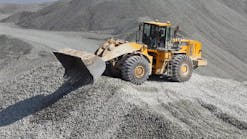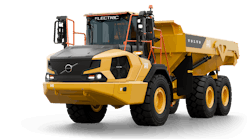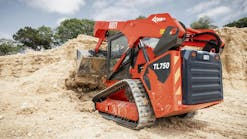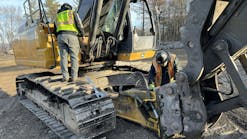Vibratory soil compactors are usually the least conspicuous machines on road-building projects. Either they're long gone before the more glamorous paving train arrives, or they're working so far ahead of the train as to be all but invisible. But the best pavements in the world don't have a ghost of a chance at long-term survival unless an inconspicuous soil compactor has worked its magic on the underlying layers of material that support the pavement.
Construction varies, but the pavement's foundation, from the bottom up, could consist of a compacted native-soil sub-grade; next a sub-base of treated soil, usually compacted in multiple layers or "lifts"; and then a base course, often a layer of uniformly sized aggregate that also may be compacted in multiple lifts. The thickness and composition of foundation layers depends primarily on the loads the pavement must eventually sustain.
Done effectively, compaction creates a roadway foundation that has high load-bearing capacity, high stability and low permeability—qualities that reflect upward into smooth-riding, long-lasting, low-maintenance pavements. Conversely, under-compaction or over-compaction (too much compaction actually loosens materials) result in a poor foundation, with pavement settlement, deformation and frost damage as consequences.
Working with soil compactors
Given the critical job assigned to the vibratory soil compactor on roadway jobs, getting the right machine on site is important, especially on sites where the compactor must keep pace with a fleet of haul trucks and motor graders spreading fill. Contractors who already have soil compactors in their fleets, of course, likely will try using what they have (assuming existing units meet any qualifiers in the bid). On the other hand, if supplemental machines are needed, then the acquisition of these units, whether purchased or rented, should be as analytical as choosing the trucks and graders.
Caterpillar Paving Products recently sent Construction Equipment a study ("Fine Tuning Soil Compactor Selection") that assesses requirements on typical North American compaction jobs, then analyzes the performance of three machines (same drum width, but different operating weights) as specifications change. When we look more in detail at this study, you may find it interesting that heavier, more expensive machines may not provide any real production advantages until lift thickness and density substantially increase.
Also requiring analysis—and often experimentation—is deciding how best to use a machine on a particular site, whether it's a familiar machine long in the fleet, or one that's been newly rented. To illustrate, during a Construction Equipment field test, we worked with a Bomag Americas customer who was using a Bomag BW213D-3 to compact an 8-inch base of 1-inch lime rock over a clay/sand sub-base for streets in an Orlando, Fla., development.
Based on experience, the Florida contractor chose to operate the machine in the lower of its two amplitude settings—amplitude being a measure of the drum's vertical travel. The contractor made this decision even though the low amplitude setting (0.036 inch) produces only 44,550 pounds of centrifugal force (compaction force), compared to the high amplitude setting (0.071 inch), which produces 61,825 pounds. In low amplitude, though, the drum operates at a higher frequency, delivering 2,160 vibrations per minute (vpm), compared to the high amplitude's 1,800 vpm. (Frequency is reduced at higher amplitudes to lessen the load on drum bearings.)
A nuclear density gauge confirmed the contractor's low-amplitude/high-frequency strategy. The gauge showed higher dry-density readings (a measure of compaction) per pass for the BW213D-3, than for an older, comparably sized machine on site that had only a single amplitude (0.068 inch) and single frequency (1,800 vpm). Both were operated at speeds to yield the same number of impacts per foot of travel.
Depending on the material, some contractors use dual-amplitude capability as a means for "two-stage" compaction, that is, the high setting for initial passes, then the low for later passes as the material builds density. This strategy works well in some situations, but experimenting to find the best combination of operating parameters is probably always the most expedient approach. But by all means, avoid over compaction, which can turn the upper inches of certain soils to useless dust, while also damaging the flexible isolators that mount the drum to the machine's front frame.
(To clarify, amplitude settings usually given in machine specifications are more correctly defined as "nominal amplitude," one-half the drum's total vertical travel, since only downward movement into the lift is useful.)
Vibratory basics
Although designs vary, soil compactors typically generate their vibratory action (rapid vertical movement of the drum) by means of rotating eccentric weights in the drum. The resulting centrifugal force varies with mass, velocity and the distance the weights are positioned from the center of the drum. A machine with dual amplitude settings often accomplishes its two-setting capability by reversing the direction of weight rotation. Frequency is determined by the speed of the eccentric weights, which are driven by a hydraulic motor.
The total force a soil compactor exerts at the ground, however, also encompasses the weight of the drum, plus that portion of the machine's weight (sprung weight) exerted on the drum through the isolator system.
Although scientists debate exactly how vibratory action accomplishes compaction, the basic principle seems to be particle rearrangement. As the soil compactor's drum strikes the ground at a rate of 1,000 to 2,500 vpm, soil particles move closer together, perhaps the result of temporarily reduced friction. As voids between particles decrease, the soil becomes more dense, that is, it weighs increasingly more per given cubic volume.
Compaction theory says that vibratory action builds density in materials principally from the bottom up. Impact forces, imparted by the vibrating drum, pass through the lift to be compacted, strike harder material below, then reflect upward and incite particles to move closer together.
Drums and power
Look at a list of soil compactors available in North America, arranged by ascending operating weight, and you'll find that when weight begins to exceed 10 tons, drum width takes an abrupt jump, from around 66 to 84 inches. These "84-inch rollers" usually are considered high-production models, heavier (and thus exerting more impact force) than their narrower-drum counterparts, and able to cover a typical roadway lane in two passes with adequate overlap. Weight ranges from 10 to 28 tons, and most of these larger units drive both their drum and rear wheels (or tracks) hydrostatically, that is, with a hydraulic-pump-and-motor system.
Soil compactors, of course, are available in two basic versions: smooth-drum and padfoot-drum, the latter having block-like protrusions from the drum's surface. When consistently working in granular soils, like sand and gravel, the smooth-drum is most efficient. But when consistently compacting cohesive, fine-grained soils, like clay and silt, which may have a sticky nature, the padfoot is the better choice.
But how do you make the choice in mixed soils? No absolute criteria here, but one manufacturer suggests using the padfoot when the fine-grained content of a soil exceeds about 35 percent. The padfoot more intensely concentrates the compactor's energy, thus more effectively overcoming the shear resistance (internal friction) of cohesive soils. It also exposes more surface area for better evaporation of moisture, and helps squeeze water out of wet soils.
You can work in a wider range of soils and conditions, however, if you have a padfoot shell to bolt over your smooth drum. (At least one manufacturer offers a smooth shell to bolt over a dedicated padfoot drum, as do certain after-market suppliers.) The padfoot shell, though, adds considerable weight to a machine, and gradeability may be adversely affected in extreme situations. But this is seldom a major concern.
Most smooth-drum models have adequate power to handle the heavier padfoot shell, even though the shell increases rolling resistance for the machine. But, in a few instances, the padfoot shell may be sold as a "kit," which includes larger hydraulic drive motors. Some manufacturers make heavy-duty versions of certain smooth-drum models (having more horsepower and larger hydraulic motors), and it's probably smart to choose the beefier version if you intend to use the padfoot shell regularly, or if the machine will be used often in hilly terrain. Dedicated padfoot machines also may have more engine and hydraulic power than their smooth-drum counterparts.
On-the-run density checks
Most soil compactors can be equipped with an optional device that provides an on-the-run indication of material stiffness. Essentially, these devices use accelerometers, linked to a microprocessor, to measure drum bounce against stiffening material. This motion is converted to a reading on an in-cab indicator gauge. If you correlate these readings with dry-density readings from a nuclear density gauge, then the in-cab gauge can become an indicator that tells the operator when specified density has been attained.
Some density-indicator systems, in fact, can be programmed with the Proctor target (a common measure of the density specification), and other systems use colored lights to indicate when a material has reached maximum stiffness. Overall, these on-board, density-indicator systems help make optimal use of the machine and the operator's time. System cost may range from $8,000 to $25,000, depending on sophistication, such as integrating an on-board printer for documenting compaction results.
It's estimated that perhaps 5 percent of North American machines are equipped with density-indicator systems, compared to maybe 50 percent in Europe generally, and 100 percent in specific European countries. If you have a fleet of soil compactors, of course, you could equip only one machine with a system, then use it as the proof roller to establish patterns and parameters for the other machines.
| Acknowledgements | ||
| Special thanks to these companies and individuals for assistance in assembling this report: | ||
| Ammann America, Martin Lehmeier; Case, Rusty Schaefer; Caterpillar Paving Products, Terry Sharp; Bomag Americas, Steve Wilson; Ingersoll-Rand, Dale Starry and Mickey Benedict; Sakai, Dave Brown; Terex Construction, Dean Barley; Troxler Labs, Robin Myers; Vibromax America, Tom Meyer; and Wirtgen America (Hamm Compaction Div.), Bruce Monical. | ||




